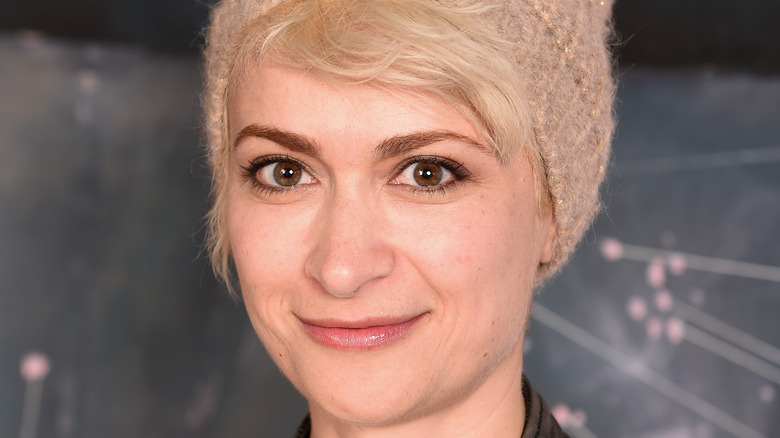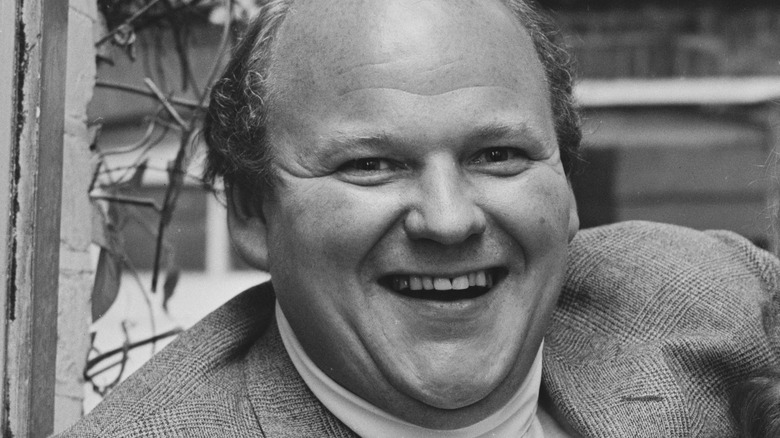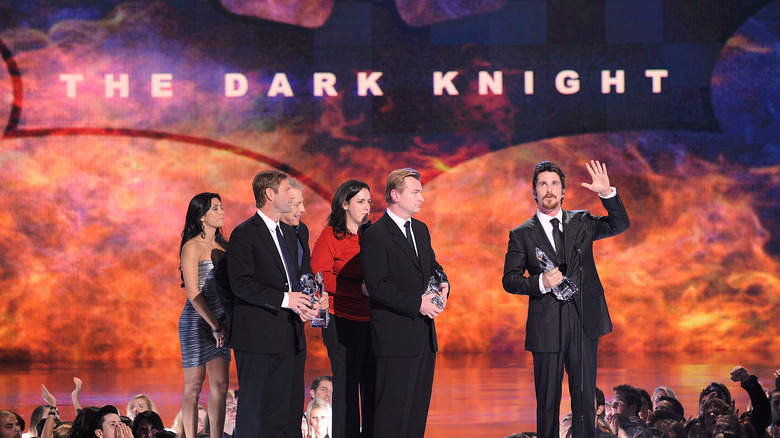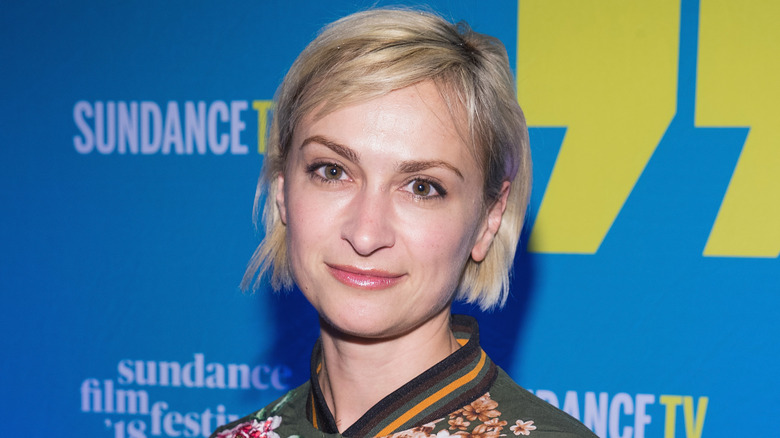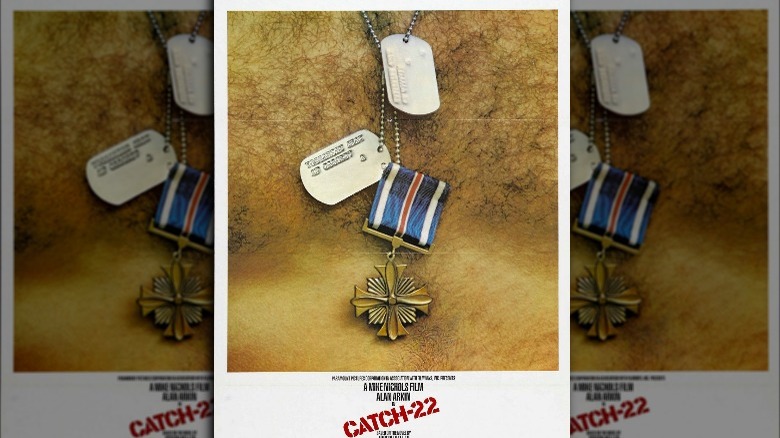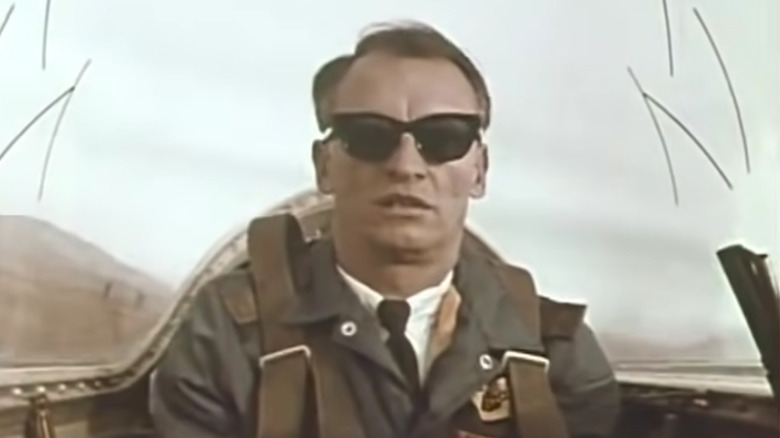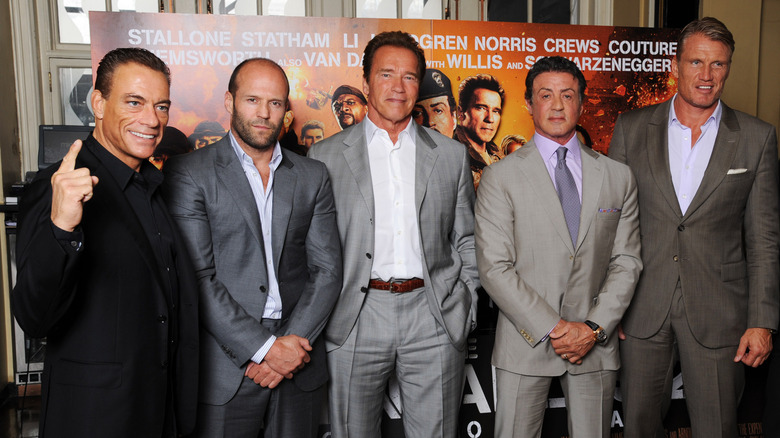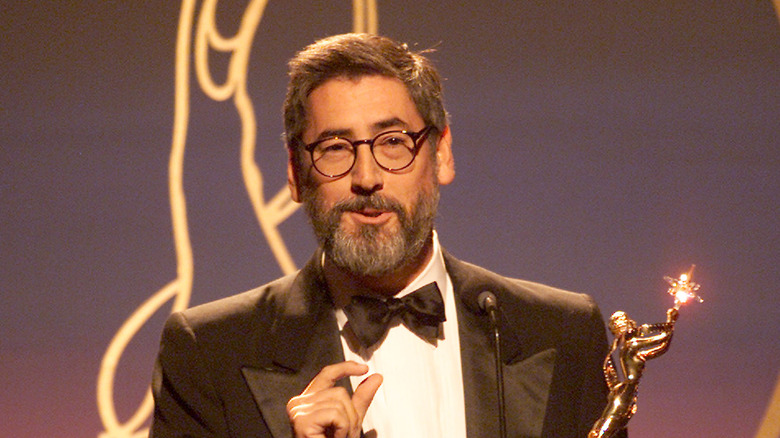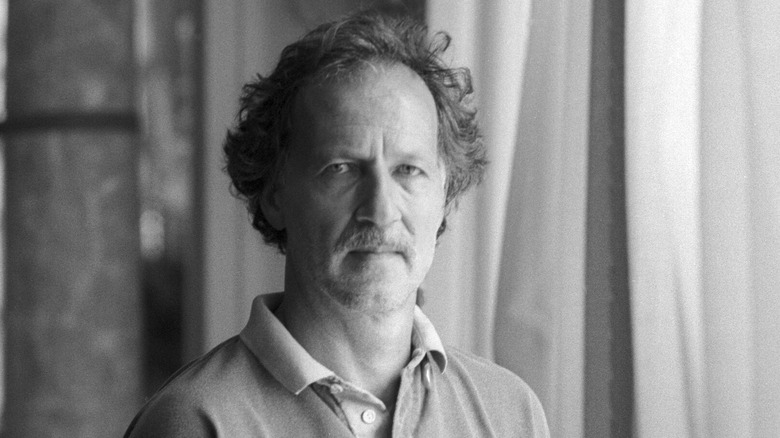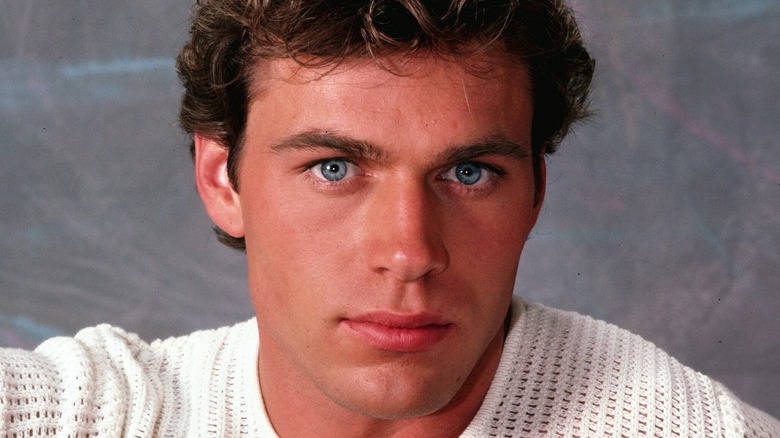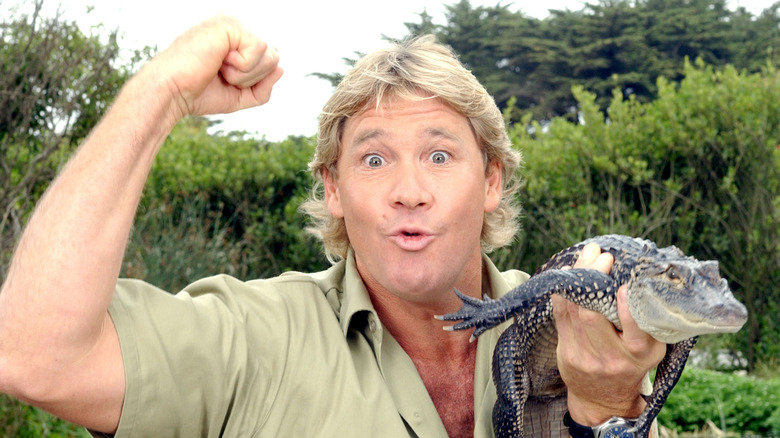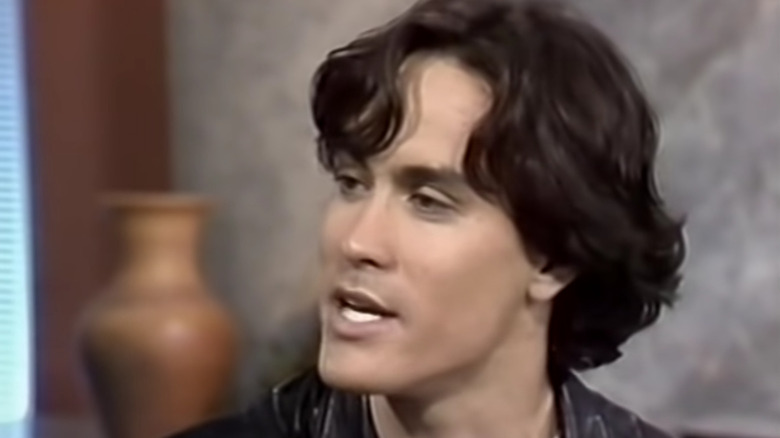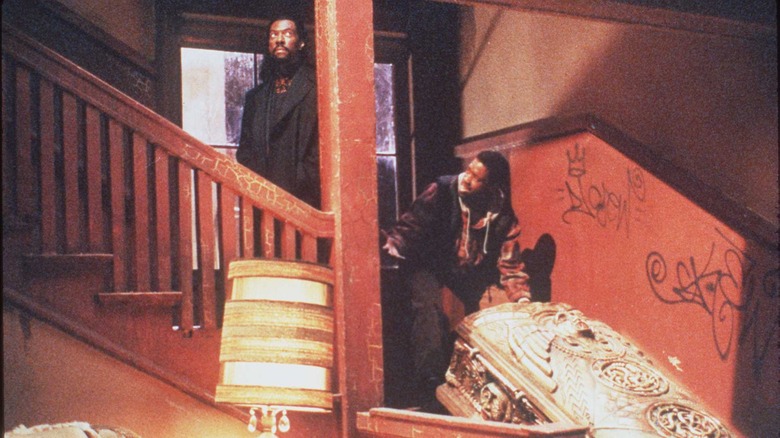These People Were Killed On The Set Of A Movie
Safety on movie sets has been a hot-button issue since it was announced that cinematographer Halyna Hutchins had died while working on Alec Baldwin's film "Rust." But film crew unions like IATSE have been trying to expose the unfair and sometimes dangerous working conditions in Hollywood for years.
As Jacobin reported, the industry has become notorious for long working hours, which sometimes lead to workers crashing their cars after particularly difficult days. "A standard working week for us, not including travel time, is about sixty hours," one lighting technician explained, adding that these conditions lead to health issues. "I'm out of the house fifteen hours a day for a twelve-hour-day shoot."
And sometimes those overworked and underpaid film crews end up injured or worse because of their unsafe surroundings. Keep reading to find out about some of the most bizarre and tragic on-set deaths in the history of Hollywood — and how they could have been prevented.
Roy Kinnear
Director Richard Lester stopped making films after the death of his frequent collaborator Roy Kinnear, following a horse-riding accident on the set of swashbuckler "The Return of the Musketeers" where the actor broke his pelvis. Although Kinnear was rushed to the Ruber International Hospital in Madrid, as The New York Times reported, the "Willy Wonka & the Chocolate Factory" star had a heart attack and died.
His tragic death led to a lawsuit against the production company, which ended up paying the Kinnear family £650,000 damages as well as their legal costs. "That night is indelibly printed on my mind forever," his widow Carmel stated in court, per the Independent. After the settlement was announced, she said that "justice" had been delivered. "Somebody can't just die and we all forget about it. Nothing will ever make up for the last six years of hell or the rest of our lives without him."
His son Rory, who followed in his father's footsteps and became an actor, told The Guardian that Kinnear still has his fans in the industry. "I still meet people today who say they were very affected by his death," Rory explained, talking about how many people loved his father. "But working in the business now, everyone has a new story about him, and every new story is a nice story." He also insisted that Kinnear would have approved of his son's acting career. "He would have been happy, if I was happy," Rory added.
Conway Wickliffe
Although "The Dark Knight" became an Oscar-winning smash hit, the Batman sequel was overshadowed by the tragedy of Heath Ledger's death. And the Joker actor wasn't the only person who died before the film's release: special effects technician Conway Wickliffe was killed when the four-wheel-drive he was riding in crashed into a tree.
While filming a stunt in the English town of Chertsey, Wickliffe apparently wasn't wearing a seatbelt, as The Guardian reported. His vehicle was supposed to follow the action so that the New Zealand-born technician could shoot the scene with a handheld camera through his car window. When it hit a tree instead, Wickliffe suffered severe head injuries and later died in hospital. He had two children.
According to Reuters, the studio confirmed that there had been "a fatal accident" at the time. "A special effects technician on the film was in a truck that struck a tree at the end of a test run-through," they stated. The filmmakers behind "The Dark Knight" decided to acknowledge his death in the movie, per the BBC, with a dedication to their "friends" Ledger and Wickliffe.
Halyna Hutchins
A freak accident on the set of Alec Baldwin's movie, "Rust," shocked the world when it was announced that Baldwin had shot cinematographer Halyna Hutchins with a gun he didn't know was loaded. According to an affidavit published by Deadline, the assistant director handed it to Baldwin, declaring that it was a "cold gun" and therefore had no live rounds. Director Joel Souza was also injured when the actor shot towards the camera while practicing the scene.
Questions have since been raised about the film's production. "To save a dime sometimes, you hire people who are not fully qualified for the complicated and dangerous job, and you risk the lives of the other people who are close and your lives as well," gaffer Sergey Svetnoy, who held Hutchins as she died, wrote on Facebook. He then accused them of caring more about the budget than their employees, several of whom had walked out earlier that week.
"There are no words to convey my shock and sadness regarding the tragic accident that took the life of Halyna Hutchins, a wife, mother and deeply admired colleague of ours," Baldwin tweeted after the news broke, adding that he was working with the official investigation to uncover how exactly it happened. "I am in touch with her husband, offering my support to him and his family," the actor added. "My heart is broken for her husband, their son, and all who knew and loved Halyna."
John Jordan
Out of all the camera operators to ever work in Hollywood, John Jordan must have been one of the most daring. Despite being severely injured on set, he continued to risk his life to achieve stunning shots.
In an interview with Bond Pix, pilot Kenneth Wallis explained how Jordan was first injured while shooting the 1967 James Bond film "You Only Live Twice," during a helicopter fight sequence. "There was a nasty accident in which the cameraman John Jordan lost his leg when one of the other helicopters collided with the camera helicopter in what should have been a close pass," he recalled. "At that altitude one needs to allow a bit more space for the control response."
The blades of a Bell 47 helicopter almost took his foot completely off, per the Independent. Although it was quickly reattached by talented surgeons who were coincidentally gathered nearby for a conference, Jordan eventually had his leg amputated anyway. His brush with death clearly didn't scare him away from filming air battles, since the cameraman later fell out of a plane while filming "Catch 22." According to the Los Angeles Times, Jordan plummeted 4,000 feet into the Atlantic ocean after a passing aircraft made his bomber overbalance. A daredevil until the end, he wasn't wearing a harness or a parachute.
Art Scholl
When "Top Gun" was released in 1986, it quickly won over America with its stunning action sequences and charismatic lead performance from Tom Cruise. The film was also dedicated to the memory of Art Scholl, a stunt pilot who lost his life in a horrible accident while shooting the movie.
As The Los Angeles Times reported, Scholl had gone from teaching aeronautics to becoming one of the best stunt pilots in the country. As well as flying for the US aerobatic team, he had flown in movies like "Indiana Jones and the Temple of Doom," "The Right Stuff," "Amelia Earhart," and "The Amazing Howard Hughes." While performing an inverted spin 4,000 feet over the Atlantic Ocean while filming "Top Gun," however, something went wrong.
According to aviation website Check-Six, he spoke over the radio while descending. "I've got a problem," Scholl said, before repeating himself at 1,500 feet: "I've really got a problem." Spotter planes arrived shortly afterward, but he had disappeared. Although the Coast Guard searched for Scholl's body and the wreckage of his plane, they were never recovered. Although it is speculated that the father of two was thrown off by the weight of his camera equipment, the circumstances of Scholl's death remain a mystery today.
Kun Lieu
In "The Expendables 2," Sylvester Stallone reunited with stars like Jet Li, Jason Statham, and Bruce Willis for a high-octane flick that delighted action fans. But one of those explosion sequences went disastrously wrong when stuntman Kun Lieu died on set in Bulgaria, as Deadline reported in 2011. Another stuntman called Nuo Sun was also injured.
"Our deepest condolences go to the family of Kun Lieu," a representative of the production company NuImage/Millennium Films insisted in a statement. "His passing is tragic. Our sympathies also go to Nuo Sun who was seriously injured as a result of the same explosion." They continued by revealing that the other man's condition had "stabilized" after he was "transported to Munich, Germany" and that he had received medical treatment from "the best specialists."
According to the BBC, Kun Liu's parents, Zong Yu Liu and Yan Mei Bai, decided to sue the filmmakers for "the loss of society, love, comfort, attention, services and support" of their son, as well as the funeral expenses. They told reporters that the movie set had "negligently and carelessly failed to provide adequate protection from harm to the participants of the stunts."
Vic Morrow, Myca Dinh Le, and Renee Chen
The film industry was shaken in 1982 when a brutal helicopter crash on the set of "Twilight Zone: The Movie" led to Vic Morrow and two child actors dying. The scene was supposed to show Morrow saving the two kids during the Vietnam war. It was later revealed that seven-year-old Myca Dinh Le and six-year-old Renee Chen were being paid under the table by director John Landis to avoid child labor laws, per Slate. The helicopter was also being flown by a real Vietnam veteran who was terrified by the explosions.
When it crashed into the river where the cast members were standing, Renee was crushed by the helicopter's right side, while Morrow and Myca were slashed by the main blade. According to the National Transportation Safety Board, the special effects explosions had just been too close to the helicopter, causing the vehicle to crash when it went into an "uncontrolled descent." They also ruled that a lack of communication between the pilot and Landis had meant that the helicopter flew too close to the ground.
Although Landis and the producers went through almost a decade of lawsuits and criminal cases, which resulted in long term changes to the industry, they were eventually acquitted.
There were several deaths on set of Werner Herzog's Fitzcarraldo
Werner Herzog created one of the most chaotic movie sets of all time in 1982 with "Fitzcarraldo," the true story of an Irish rubber baron who tried to open an opera house in the Peruvian jungle. The German director decided that he would really move a 340-ton steamship over a hill in Peru, rather than use special effects. Several indigenous extras were killed and more were injured on the dangerous set, as Nick Thorpe reported for the Sunday Herald. When Amahuaca tribespeople "launched a hit-and-run raid on the film camp," he wrote that one man was shot through the throat with an arrow and his wife was wounded in the stomach. Both, miraculously, survived.
"The disastrous run of bad luck intensified. There were two plane crashes ... and the death of a young highland Indian who drowned after borrowing a canoe without permission," Thorpe continued, adding that another local had to saw his own foot off with a chainsaw after a dangerous snake bit him. In Herzog's book "Conquest of the Useless," he admitted that "bad luck" seemed to plague the entire shoot.
Herzog defended his dangerous shoot, however, by comparing himself to his own subject. "This is a film that challenges the most basic laws of nature," the director told the Herald, calling himself a "Conquistador of the Useless" in his vision. "Boats just are not meant to fly over mountains. Fitzcarraldo's story is the victory of the weightlessness of dreams over the heaviness of reality."
Jon-Erik Hexum
In 1984, prop guns led to a horrible death on the set of the CBS series "Cover Up." Star Jon-Erik Hexum was 26 when he was filming the action-adventure show, per Entertainment Weekly, which would have been his big breakthrough role. After filming was delayed again on a particularly long day, the actor began joking around with a prop gun as though he was playing Russian Roulette, reportedly asking "Can you believe this crap?" When he pulled the trigger, Hexum fatally shot himself in the head.
Although the gun didn't contain any real bullets, blanks can still be dangerous when they're fired within a few feet of somebody's head. The blast from the gun was explosive enough to damage his skull, which meant Hexum had to be rushed to the hospital for a five-hour surgery, as The New York Times reported at the time. Doctors couldn't save him, but they were able to use his heart in a life-saving transplant, per Entertainment Weekly.
"It gave an opportunity for my two kids to still have a father," said former Navy SEAL Michael Washington, who received the heart. He also made it clear that the Hexum family had given their blessing.
Steve Irwin
Fans across the globe were heartbroken when it was announced that Australian animal expert Steve Irwin had been killed while filming a documentary in 2006.
The Crocodile Hunter had been recording his last-ever project "Ocean's Deadliest," per The Washington Post, which showed Irwin traveling on his research boat "Croc One" and discovering the world's most dangerous aquatic species. One of those species led to his untimely death, however, when the beloved host was stung by a stingray. As CNN reported, its barb probably pierced his heart directly.
After a private funeral was held, Australia Zoo hosted a public memorial to pay tribute to Irwin's conservation efforts, per E! Canada. 4,000 of his most devoted fans showed up in person and an estimated 300 million people watched online from around the world. "Please don't grieve for Steve — he's at peace now," Irwin's father told the attendants. "But I would like you to grieve for the animals — the animals have lost the best friend they ever had, and so have I."
According to the Los Angeles Times, Irwin's final moments were recorded and that footage still exists but everyone working on the film, including his widow Terri and Philippe Cousteau Jr., agreed that it would never be shown. The final documentary is dedicated to Irwin's memory but doesn't address his death.
Brandon Lee
Years after martial arts legend Bruce Lee died mysteriously while filming his last movie, his son Brandon Lee was shot on set and died at age 28.
As the Los Angeles Times reported in 1993, the young actor was on the verge of becoming a star in "The Crow," playing the dark fantasy film's lead role. A scene involving his character being shot went tragically wrong when Brandon was hit in the abdomen by a cartridge that had gotten stuck in the prop gun. Although he was rushed to the hospital for surgery, nobody realized he had actually been shot by costar Michael Massee until after his death, when an autopsy found the bullet close to his spine.
Brandon's death was ruled an accident by negligence, according to The New York Times, after a lengthy investigation into why a gun supposedly loaded with blanks had fired a real bullet.
So, what happened to Michael Masse after Brandon Lee's death? The circumstances of the death haunted him for years, as he told ExtraTV in 2005. "What happened to Brandon was a tragic accident. It's something I'm going to live with," Masse stated, per CNN.
Sonja Davis
When Eddie Murphy teamed up with Wes Craven to create the horror film "Vampire in Brooklyn," no one could have predicted that it would lead to a horrific real death on set.
As the Los Angeles Times reported, Angela Bassett's stunt double Sonja Davis sustained critical injuries while performing a 42-foot backwards drop. "This airbag was as big as a house, it filled the alley entirely. That's why there was no ambulance on set," cinematographer Mark Irwin told Hopes and Fears. "Sonja had done all the moves, she was aware of the scene. Leading up to the fall she was hanging on the side of the building, or it was supposed to look like that." He recalled that Davis hit her head as she fell and almost completely missed the airbag. "She landed at my feet."
Fellow stuntwoman Lafaye Baker observed that Davis was "just getting to the top" at the time. "She was so well-liked and had such a great personality. It was just so tragic," Baker added. And in a heart wrenching twist, her mother and brother happened to be on set that day. The Davis family sued Paramount afterward for $10 million, but as they understandably made clear, no amount of money could bring their daughter back.

